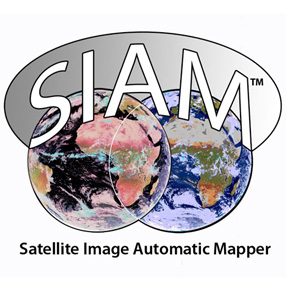Points of Contact:
SIAMtm (Satellite Image Automatic MapperSIAMtm) is an off-the-shelf lightweight computer program, suitable for running on web services and/or mobile devices, such as tablet computers and smartphones, whose goal is to accomplish low-level (pre-attentive) computer vision (CV) tasks in Earth observation (EO) multi-sensor multi-spectral (MS) imagery.
The SIAM process is: (a) near real-time, its computational complexity increasing linearly with image size, and (b) fully automated, i.e., without human-machine interaction: to run, SIAM requires neither training data nor system’s free-parameters to be user-defined based on heuristics.
The SIAM toolbox accomplishes three low-level CV tasks:
- MS color naming. It means that SIAM calls each (numerical) MS color value, specifically, any vector data belonging to a multi-sensor MS reflectance (hyper)space, by a (categorical) MS color name. Belonging to a discrete and finite vocabulary of MS color names, known a priori, each MS color name is equivalent to a (hyper)polyhedron in the MS data (hyper)cube.
- Superpixel (image-object, planar segment, patch, texel) detection in the (2D) image-domain.
- Vector data quantization (discretization) quality assessment in the (2D) image-domain.
On a standalone basis, SIAM is suitable for (independent, third-party) validation of MS sensory data, acquired by any past, present or future MS imaging sensor and radiometrically calibrated into top-of-atmosphere reflectance, surface reflectance or surface albedo values.
In a multi-stage Earth observation (EO) image understanding system, capable of colorimetric and spatial analytics based on a hybrid (combined deductive/ top-down/ physical model-based and inductive/ bottom-up/ statistical model-based) convergence-of-evidence approach to scene-from-image reconstruction and understanding, the SIAM deductive color naming works as first-stage CV subsystem, suitable for secondary color analysis preliminary to dominant spatial analytics.
 |
 |
 |








